Share on:


Teguar is a Charlotte, North Carolina, based hard-charging provider of industrial and medical computers that's been rapidly moving up on the Inc. 5000 list. Launched in 2010 by a Swiss native with years of experience in industrial computer systems, Teguar prides itself in combining American adaptability and technological leadership with Swiss precision, quality and attention to detail. In this article we're analyzing the Teguar TB-4845, an inexpensive, very compact fanless industrial Mini PC that fits almost anywhere, but has an amazing number of industrial and commercial applications.
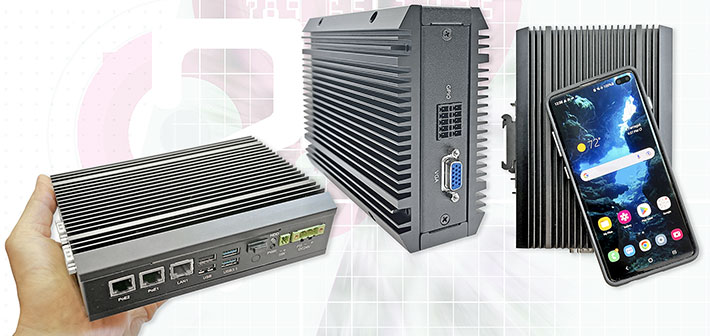
Industrial PCs are often called "Box PCs" due to their boxlike design. They are far removed from the desktop/notebook/tablet/smartphone classification that 99.9% of all consumer and enterprise PCs fall in. Yet, industrial PCs represent a multi-billion dollar market that fills a very important role. In industrial applications there isn't always a lot of room, installations aren't always very accessible or easy to service, and processing performance requirements are predictable. That's where inexpensive industrial Mini PCs fit in. So let's take a look at the overall concept of the industrial computer, and then the Teguar TB-4845 itself.
The purpose of an industrial PC is to bring computing power into areas where laptops or commercial desktops don't fit or won't do. That can be places where it's too cold or too hot for a regular PC to survive, or places that can't easily be reached so that compact size and complete reliability become important. That includes deployments where even a fan becomes an unacceptable contamination and reliability risk. Industrial computers must also comply with much more demanding ruggedness standards, including vibration, shock as well as conformance with EMC and safety regulations.
Finally, industrial PC performance and functionality differ from what's expected from a standard PC. An industrial PC must be configurable for a vast variety of deployments, each with its I/O, performance and standards requirements.
Uses of an industrial Mini PC like the Teguar TB-4845
Like any other general purpose computer, industrial Box PCs have almost limitless application potential. Like desktop PCs, their BIOS and system boards are very highly configurable. Unlike standard PCs, industrial computers are ruggedized to withstand wider temperature ranges, impact, vibration and industry-specific hazards. Among the super-compact Teguar TB-4845 Mini PC's differentiating features and applications are:
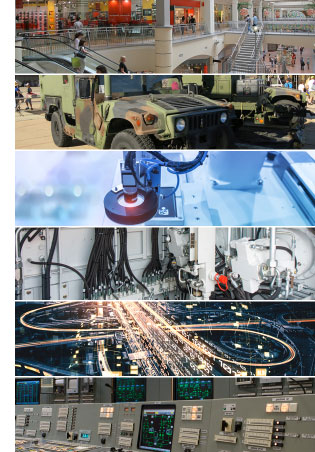
- Industrial controls systems — Providing computing power for industrial control systems in even the tightest places. Suitable for clean rooms, food processing, logistics, transportation, mining, manufacturing, pharmaceutical, military, building automation and plenty more.
- Medical environments — In healthcare settings, space is often at a premium, budgets are tight, and noiseless, fanless operation is desired.
- Commercial applications — These require immunity to environmental impact as well as reliable 24/7/365 operation without the need for frequent maintenance. Applications are in kiosks, signage, POS, transportation, etc.
- Fanless operation — With its minimal power requirements and heat generation, the TB-4845 does not require potentially troublesome, air-moving fans, addressing reliability issues as well as clean room requirements.
- PoE — Some peripherals, such as cameras, need data as well as power, and that's where PoE — Power over Ethernet — comes in. This reduces the number of cables and wires, and unlike powered USB, PoE cabling can be as long as 330 feet.
- DIN rail mounting — DIN rail mount allows for easy, space-saving integration into industrial IT systems — simply seat the bottom of the clip into the rail, then press in and up until it clicks into place.
Teguar TB-4845 — Good thing in a small package
The Teguar TB-4845 measures a very compact 7.1 x 5.1 x 2.2 inches and weighs just 4.2 pounds. That's quite small and light by conventional desktop PC standards, and also more than compact enough to fit the system just about anywhere. In terms of design, when it comes to industrial Box PCs, form follows function more than in any other type of computer. There's a metal box — usually steel or aluminum — to mount the boards on, and solid, finned aluminum that soaks up and dissipates the heat generated by the processor and ancillary electronics. The processor used in the TB-4845 doesn't generate a lot of heat that needs to be removed, but without a fan and often often installed in tight places, cooling is of utmost importance for reliable operation and a long service life.
It is therefore I/O ports and thermal management that drive industrial box computers' design. About the only thing not dedicated to those two primary functions is the DIN rail mount option, a standard used for mounting industrial control equipment inside equipment racks, on walls or other surfaces.
The picture compilation below shows one of the Teguar TP-4845's finned heatsinks and its left, right, top and bottom sides:
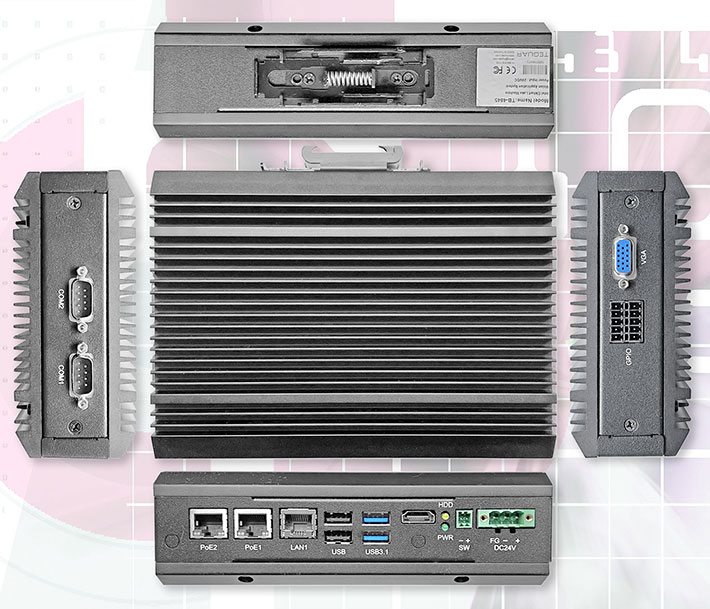
Many TB-4845 customers will use DIN mounting, but without the DIN adapter, the system can be mounted ion other ways, or it can just stand up so that its two finned aluminum heatsinks are exposed to air and can do their job. I/O ports are on all three exposed sides. In the standard configuration, available I/O consists of:
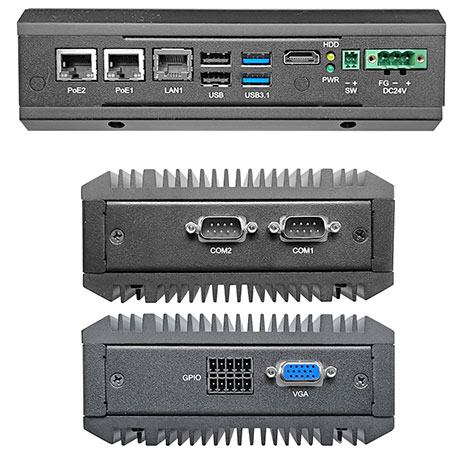
Top side:
- 2 x RJ45 gigabit LAN with 30 watt PoE out
- 1 x RJ45 gigabit LAN
- 2 x USB 2.0 Type-A
- 2 x USB 3.1 Type-A
- 1 x HDMI
- Phoenix-type 3-pin DC-In
Left side:
- 2 x DB9 RS-232/422/485 COM
Right side:
- 1 x 8-bit GPIO
- 1 x 15-pin VGA
As far as ruggedness goes, the TB-4845 IPC is not an inherently mobile device, so there are no drop specs and other testing results that would be primarily relevant to mobile systems. The TB-4845 can be operated in an exceptionally wide temperature range from -4 to 158 degrees Fahrenheit, and the entire unit is about as rock-solid as it gets. Do note that the TB-4845 is not a sealed unit and there is no Ingress Protection rating, and the unit must not be exposed to dust and liquids.
A look inside
As stated above, almost all industrial Box PCs use a simple, functional design — the housing consists of a metal box that contains the computer and ancillary electronics. And that box is usually sandwiched between two heavy, finned aluminum heatsinks and heat spreaders. For reliability, maintenance and other (like lack of air movement/disturbance) reasons industrial box PCs generally don't have cooling fans. Heat is dissipated passively via the cooling sinks. There are exceptions where a fan is attached to one of the finned heatsinks, boosting its heat dissipation capability. Due to the low (10 watt) thermal design power of the processor used in the TB-4845, there should be no need for additional cooling under any operating conditions.
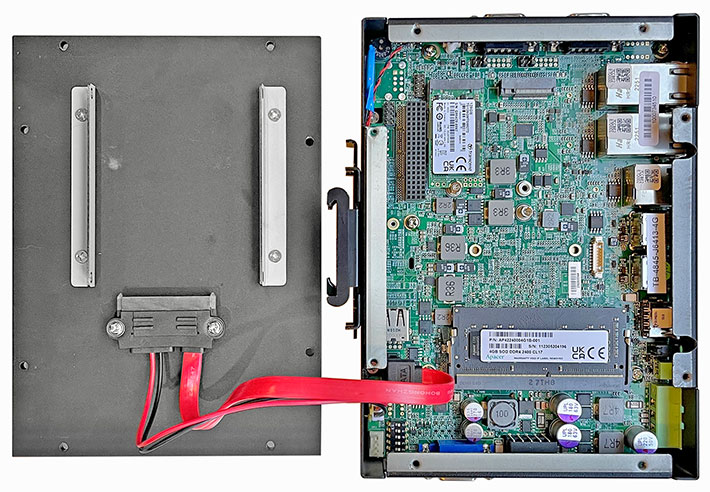
Following the standard IPC design school, the TB-4845 consists of a metal box that's just large enough to accommodate the roughly 6-1/2 x 4-1/2 inch motherboard, and then heavy finned aluminum covers on either side to provide stability and cooling. Like most IPCs, the TB-4845 provides a generous complement of edge-mounted I/O, especially considering its compact size. In fact, the TB-4845 offers so much wired connectivity that I/O ports take up three sides of the unit rather than the usual one or two on larger designs.
Gaining access to the insides of the TB-4845 is easy. Undo eight small screws and the top comes right off. There's the single SO-DIMM RAM connector and you can see the two M.2 expansion slots. One is for the unit's SATA3 2232-type 256GB solid state disk module (up to 1TB is optionally available), and the other for an M.2 3042/3052 Key B optional 4G/5G cellular expansion module.
There seems more expansion potential on the board. The red cable has a SATA disk connector and there's room for a standard 2-1/2 inch hard disk or SSD. There's also an internal USB Type-A port, a debug port, and an 80-pin (four rows of 20) expansion connector with unknown purpose.
Power over Ethernet (PoE)
As listed above, two of the three RJ45 LAN ports of the TB-4845 provide PoE — Power over Ethernet. Why power over Ethernet when peripheral devices might have their own power? PoE eliminates the need to run a separate power cord to each connected device or install extra power outlets near connected devices.
 The availability of PoE can be a big plus in large facilities, or if the goal is to keep electrical wiring at a minimum. PoE can also simplify the often cumbersome instillation of electric lines for extra savings in time and money.
The availability of PoE can be a big plus in large facilities, or if the goal is to keep electrical wiring at a minimum. PoE can also simplify the often cumbersome instillation of electric lines for extra savings in time and money.
Note that a PoE cable can theoretically be as much as 100 meter (330 feet) long, with Ethernet being the limit, not power. As is, Teguar generally recommends not to exceed 50 meters. Note that while there are powered USB ports, powered USB is limited in distance compared to PoE.
What are some common uses for Power over Ethernet? One is machine vision, which refers to the use of high-speed cameras to monitor production processes, have machines analyze the captured data in real-time, and then use the results to flag items, initiate or change actions, or report results for further action.
As is, the two RJ45 PoE ports on the TB-4845 provide up to 30 watts of power each, with 25.5 watts available to connected devices. That means they probably use the IEEE 802.3at standard that can handle PoE Type 2 devices such as RFID readers, video IP phones, PTZ (pan, tilt and zoom) cameras, alarm systems and the like.
Intel "Elkhart Lake" processor
Unlike general purpose PCs and laptops, which generally benefit from as much performance as possible to cover all bases, dedicated commercial and industrial systems are better off with "targeted" performance, i.e. as much as is required for the job. Since performance requirements of many industrial and vertical market systems are well defined and generally far lower than for tasks like complex rendering or modelling or other compute-intensive workloads, there's no need to pay for performance that'll never be needed (nor the extra heat generated).
That said, any given system may be complex and resource-intensive, and that's why vendors of industrial and vertical market systems often provide their products with scaleable performance or with different classes of processors. Teguar does this with several of its product lines. However, sometimes it makes more sense to design a product around a single processor. The compact TB-4845 IPC with its Celeron J6413 processor is an example of such a system.
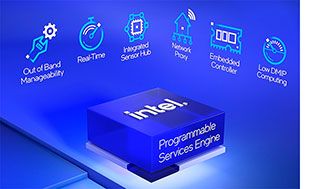 Processor naming can be confusing because Intel has been using the "Celeron" brand for budget-friendly lower end chips for a good many years, but has lately begun using them both for low-end Core processors as well as for higher-end Intel Atom-based chips. The "Elkhart Lake" Celeron J6413 in the TB-4845 is of the latter variety.
Processor naming can be confusing because Intel has been using the "Celeron" brand for budget-friendly lower end chips for a good many years, but has lately begun using them both for low-end Core processors as well as for higher-end Intel Atom-based chips. The "Elkhart Lake" Celeron J6413 in the TB-4845 is of the latter variety.
Elkhart Lake is Intel's code name for a line of lower-power processors that, while based on the relatively simple Intel Atom architecture, were enhanced to meet the specific needs of IoT — Internet of Things — "edge" devices.
What does "edge" mean in this context? "Edge computing" generally refers to using technology at the edge of the ever-growing range of modern networks and applications. That includes systems on the road, in the field, in everyday situations, and embedded industrial PCs like the TB-4845. The growing importance of all that processing performed at the outermost levels of network reach requires more connectivity, more bandwidth, and higher levels of security enabled right through new generations of processors, and that was what the Elkhart processor platform was designed to support.
Making full use of all of the new features that Intel baked into "Elkhart Lake" CPUs depends on software, systems and network architects, and it is largely invisible to users. Those interested may wish to peruse Driving Performance, Integration, and Versatility with Intel's First Enhanced for IoT Platform. What users will see is significantly enhanced processing and graphics performance compared to earlier systems running economy processors.
To provide an idea of the relative performance of the TB-4845, we ran the system through the full roster of our standard benchmark suites. For comparison we added the results of two other Teguar TB-line industrial PCs that we've tested, as well as other IPCs running on Intel Atom, Pentium and even Xeon processors. Here are the results:
|
Teguar TB-4845 performance in comparison
|
|
Performance
|
Teguar
|
Teguar
|
Teguar
|
Cincoze
|
OnLogic
|
Portwell
|
|
Model (version tested)
|
TB-4845
|
TB-3445
|
TB-5545
|
DS-1302
|
Karbon 300
|
Lynx-612G
|
|
|

|

|

|

|

|

|
|
Year tested
|
2023
|
2021
|
2019
|
2021
|
2019
|
2020
|
|
Processor
|
Intel Celeron
|
Intel Celeron
|
Intel Core
|
Intel Xeon
|
Intel Atom
|
Intel Celeron
|
|
Processor Model
|
J6413
|
N3350
|
i5-7500T
|
W-1270E
|
E3950
|
N3350
|
|
CPU Speed
|
1.80 GHz
|
1.10 GHz
|
2.70 GHz
|
3.40 GHz
|
1.60 GHz
|
1.10 GHz
|
|
Max. CPU Turbo
|
3.00 GHz
|
2.40 GHz
|
3.30 GHz
|
4.80 GHz
|
2.00 GHz
|
2.40 GHz
|
|
Cores/Threads
|
4/4
|
2/2
|
4/4
|
8/16
|
4/4
|
2/2
|
|
PassMark 6.1 Overall
|
2,384
|
1,211
|
2,583
|
10,580
|
1,347
|
713
|
|
PassMark 9 Overall
|
1,700
|
878.9
|
2,869
|
7,224
|
1,030
|
788
|
|
CrystalMark Overall
|
200,846
|
107,511
|
264,572
|
523,970
|
143,195
|
93,984
|
|
PC Mark 10 Overall
|
2,214
|
1,206
|
NA
|
6,145
|
NA
|
NA
|
|
GeekBench 5 Single Core
|
652
|
323
|
NA
|
1,262
|
NA
|
NA
|
|
GeekBench 5 Multi Core
|
1,806
|
609
|
NA
|
8,315
|
NA
|
NA
|
|
GeekBench 5 Open CL
|
2,213
|
720
|
NA
|
39,398
|
NA
|
NA
|
As always, the results of the benchmark testing are in no way to be viewed as "better" or "worse," but simply as a guide to understanding what relative performance can be expected from different processor types and components created for different types of applications.
First, note that even machines with the exact same processor — in this case the Intel Celeron N3350 — may clock in with different benchmark results. It's not unusual to see a difference of plus/minus 10-20% or even more. Again, that doesn't mean one is better than the other, it's just different purpose, tuning and configuration.
Second, always determine what overall processor architecture an Intel chip actually belongs to. Chips based on Intel Core architecture will always be much more complex, even with the same number of cores, and considerably more powerful than anything based on Intel's Atom architecture. In this lineup, for example, note how the sole Intel Core-based machine — the Teguar TB-5545 — is in an entirely different performance league even though it is based on an older chip.
Third, time moves on, technologies evolve and improve, and everything gets faster. An Atom, Celeron, or Pentium chip from the latest generation may be considerably faster than one might expect. 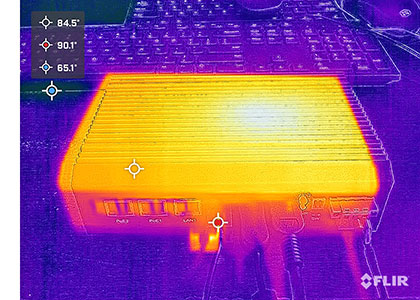 Note how the TB-4845 scores highest among the Intel Atom- and Celeron-based devices primarily because it is based on the latest chip generation. That can make a big difference.
Note how the TB-4845 scores highest among the Intel Atom- and Celeron-based devices primarily because it is based on the latest chip generation. That can make a big difference.
Finally, keep in mind that performance is entirely relative. While getting as much performance as possible is almost aways a good thing in consumer PCs and tablets, in industrial applications, where target processing load is almost always known and precisely defined, it makes no sense to spend extra for performance that is not needed.
For example, the Intel Xeon-based Cincoze IPS we included provides vast performance, but it's a much more costly machine designed for very different processing loads, and its Xeon processor alone costs ten times as much as an average Atom chip.
The colorful image above to the right was taken with our FLIR ONE Pro thermal camera. It shows how the Teguar TB-4545 remains remarkably cool even under load. Here we measured a maximum surface temperature of 90.1F, not even human body temperature, while the system was crunching a heavy-load benchmark
Teguar TB-4845 — Summary
With their TB-4845 fanless IPC, Teguar presents an inexpensive mini industrial box PC suitable for an almost endless range of applications where space and budgets are tight, required performance is known, and absolutely reliable long-term operation is required.
Based on the Intel "Elkhart Lake" quad-core Intel Celeron J6413 processor and capable of running Windows 11 (some older Intel chips in this range can't!), the TB-4845 is ideal for industrial shop floor cabinets with their space constraints, but also connecting to the cloud, monitoring production, controlling machinery, turning on/off equipment, or a myriad other IoT gateway or edge-type of computing tasks.
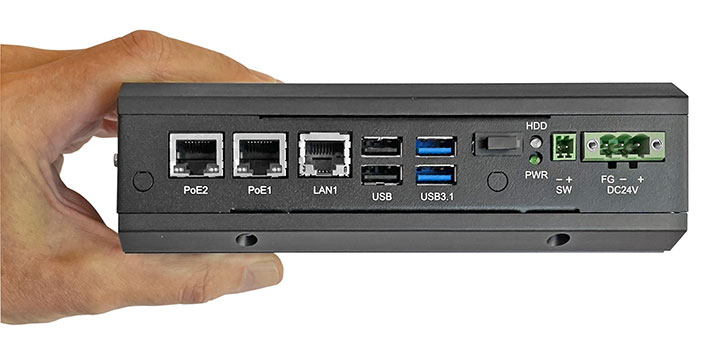
The Teguar TB-4845 offers excellent onboard connectivity, including HDMI and VGA video, dual USB 2.0 and dual USB 3.1 Type-A ports, dual DB9 legacy serial ports, as well as 8-pin GPIO and three gigabit RJ45 LAN jacks, two of which — in the POE version of the TB-4845 — providing Power over Ethernet. For mass storage, the TB-4845 uses an M.2 SATA SSD. A second M.2 port allows for optional expansion such as 4G/5G mobile broadband.
With its wide-range power input (9 to 36 Volt DC) and rugged all-steel/aluminum construction, the fanless Teguar TB-4845 can operate in the tightest spots and in the harshest industrial environments. And it is also of special interest for customers who wish/need Windows 11 in a Celeron-based system. —
Conrad H. Blickenstorfer, September 2023
Teguar TB-4845 fanless industrial Mini Box PC Specs
| Added/changed |
Full review 09/2023
|
| Type |
Fanless Industrial Mini PC
|
| Processor |
Intel "Elkhart Lake" Celeron J6413 quad-core
|
| Processor speed |
1.8GHz base frequency, up to 3.00GHz burst frequency
|
| TDP |
10 watts |
| Thermal |
Fanless passive cooling |
| OS |
Windows 11 Professional, Windows 10 Professional, Windows 10 IoT |
| Graphics |
Intel UHD Graphics for 10th Gen Intel Processors
|
| Memory |
4GGB to 32GB DDR4 SO-DIMM in one user-accessible socket |
| Storage |
1 x 64GB or 256GB mSATA Solid State Disk
|
| Expansion slots |
1 x M.2 3042/3052 Key B (for 4G/5G Cellular expansion option)
|
| Housing |
Steel and aluminum housing; wall mount, DIN rail mount option |
| Temperature |
-4° to 158°F (-20° to 70°C) |
| Humidity |
10 to 90% non-condensing |
| Vibration |
NA
|
| Spill Resistance Class |
NA
|
| Certifications |
CE / FCC Class A Certification |
| Size |
7.1 x 5.1 x 2.2 inches (180 x 130 x 55 mm)
|
| Weight |
4.2 pounds (1.9 kilograms) |
| Power |
3-pin DC 9~36Volt DC Power Input |
| Interface |
2 x USB 2.0
2 x USB 3.1
2 x RS-232/422/485
1 x RJ45 GbE LAN
2 x RJ45 GbE LAN with 30W POE out
1 x HDMI
1 x 8-bit GPIO
|
Price |
Inquire |
| Web page |
Teguar TB-4845
|
| Product data sheet |
 Teguar TB-4845 spec sheet (PDF) Teguar TB-4845 spec sheet (PDF) |
 Teguar — 1-800-870-7715
Teguar — 1-800-870-7715
www.teguar.com






